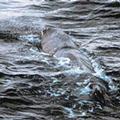 根據18日所發表的一份美國加州外海水域研究報告指出,不斷擴展的全球海運讓海底世界的環境變得更為嘈雜,也對海洋生物產生未知的影響。報告中更指出,南加州沿海海底環境吵雜的程度與1960年代相比增加了10倍。
根據18日所發表的一份美國加州外海水域研究報告指出,不斷擴展的全球海運讓海底世界的環境變得更為嘈雜,也對海洋生物產生未知的影響。報告中更指出,南加州沿海海底環境吵雜的程度與1960年代相比增加了10倍。
海洋學家希爾德布蘭德(John Hildebrand)表示:「我們已證實現在的海洋遠比40年前還要嘈雜,噪音係數是以前的10倍。」希爾德布蘭德目前任教於加州大學聖地牙哥分校「斯克雷普斯海洋研究所」(Scripps Institution of Oceanography,SIO)的海洋物理研究室。
希爾德布蘭德表示,水中環境噪音惡化的現象,應歸究於全球海運貿易的增加,全球海上活動的船隻數量,以及個別船隻的高速與推進力。該研究引述勞氏集團(Lloyd's Register)的統計數據指出,全球商務船隊比38年前多2倍以上,數量從1965年的41,865艘增加到2003年的89,899艘。
 幾年前,希爾德布蘭德尋找南加州外海噪音等級的資料時,取得了一份解密資料,該資料顯示在1960年代,美國海軍就可使用水下聽聲器測量週遭海域的噪音,據此建構了一套監聽系統,並在1968年完成了詳細的聲音紀錄分析報告。之後,希爾德布蘭德研究團隊為了獲得相同地點的相似數值,使用由希爾德布蘭德研究室所研發更先進的收音儀器「聲音記錄軟體」,簡稱ARPs。
幾年前,希爾德布蘭德尋找南加州外海噪音等級的資料時,取得了一份解密資料,該資料顯示在1960年代,美國海軍就可使用水下聽聲器測量週遭海域的噪音,據此建構了一套監聽系統,並在1968年完成了詳細的聲音紀錄分析報告。之後,希爾德布蘭德研究團隊為了獲得相同地點的相似數值,使用由希爾德布蘭德研究室所研發更先進的收音儀器「聲音記錄軟體」,簡稱ARPs。
希爾德布蘭德及其團隊成員在全球各地放置ARPs,收集並分析由鯨魚、海豚、和其它海中生物所發出的聲音信號。希爾德布蘭德表示:「增加噪音對海中生物的衝擊尚未得知,如果衝擊存在,可以做什麼來保護海中動物呢?」
希爾德布蘭德建議航線可以遠離海洋動物聚集的地方。他說:「也許可以藉由縮減噪音源以減輕海洋噪音污染的衝擊,或是讓噪音遠離對噪音敏感的事物。」
The expanding global shipping trade is making the underwater world a noisy environment, with unknown effects on marine life, according to a new study of California offshore waters published Friday. The study shows a tenfold increase in underwater ocean noise off the coast of Southern California as compared with the same area in the 1960s.
"We've demonstrated that the ocean is a lot noisier now than it was 40 years ago. The noise is more powerful by a factor of 10," said John Hildebrand, a professor of oceanography in the Marine Physical Laboratory at the Scripps Institution of Oceanography at University of California San Diego.
Hildebrand says the noisier underwater environment appears to be due to the increase in the global shipping trade, the number of ships traveling the world's oceans, and the higher speeds and propulsion power for individual ships. According to Lloyd's Register figures quoted in the study, the world's commercial fleet more than doubled in the past 38 years, from 41,865 vessels in 1965 to 89,899 vessels in 2003.
Several years ago, while searching for information about noise levels off Southern California, Hildebrand obtained declassified documents that described a U.S. Navy sound surveillance system that used cabled hydrophones to measure ambient ocean noise in the 1960s. A detailed analysis of the recordings was reported in 1968.
Hildebrand's group sought to obtain similar readings in the same location using advanced listening devices called acoustic recording packages, ARPs, developed in Hildebrand's laboratory.
Hildebrand and members of his group deploy ARPs at various locations around the world to obtain and analyze acoustic signals emitted by whales, dolphins and other marine animals.
"The impact of the increased noise on marine animals is unknown," said Hildebrand. "If impacts are shown to exist, what can be done to protect marine animals?"
Hildebrand suggests that shipping lanes might be moved away from concentrations of marine animals. "The impact of ocean noise pollution may be minimized by diminishing the noise source or by separating the noise from things that are sensitive to it," he said.





